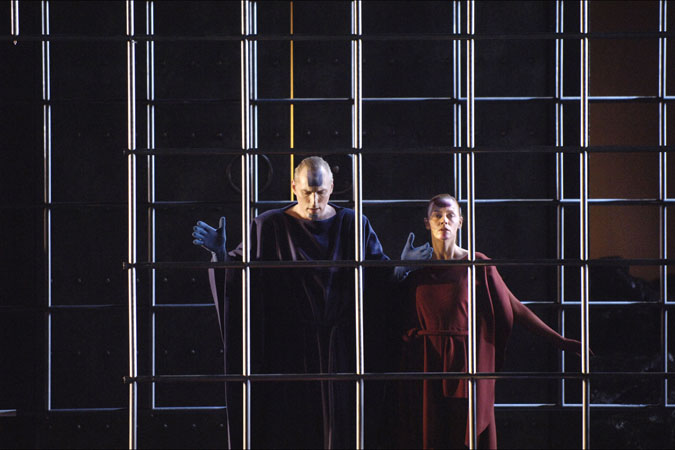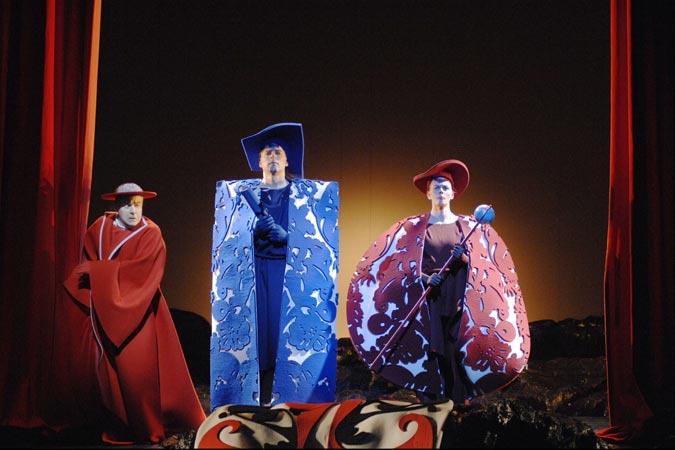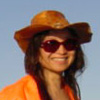Journal entries
Le Bon Journal
About
Search
Contact
Readers write
Show your support
Printer-friendly version
(4 page PDF)
Anne Ku writes about her travels, conversations, thoughts, events, music, and anything else that is interesting enough to fill a web page. She has written and produced two chamber operas, premiered in Utrecht, Netherlands. See her publication list for more.
Support the Bon Journal by keeping analyticalQ.com alive and free. Find out about Sponsorship or how else you can show your support
Bon Journal
Tan Dun's Marco Polo in Amsterdam
7 - 28 November 2008
When we were kids, my friends and I played Marco Polo in the swimming pool. “Marco!” the blindfolded person would call out. “Polo!” everyone else would shout in response. That was the only way the person could guess where everyone else was. “Marco!” “Polo!” Of course, the “Polo’s” could be moving targets. Whoever gets caught becomes the next Marco.
The librettist Paul Griffiths split Marco and Polo into two halves of the same person, not unlike the childhood game we played. Marco is the man as seen from the outside. Polo is the man as felt from the inside. In the Netherlands Opera production at the Music Theatre Amsterdam in November 2008, Marco is sung by New Zealand-born mezzo-soprano Sarah Castle. The American tenor Charles Workman sings Polo. I would have thought the woman to be the person seen from the inside and the man on the outside. Without reading the synopsis beforehand, it’s not so obvious that the two are different sides of the same Marco Polo.
Similarly, if I hadn’t heard of Tan Dun or his academy award-winning theme in Ang Lee’s “Crouching Tiger, Hidden Dragon,” I would have been confused by Tan Dun’s opera “Marco Polo.” That haunting cello solo of Yo Yo Ma from the movie made me expect any work of Tan Dun to be equally enchanting. And having scanned the synopsis and the complicated layers of the Marco Polo libretto, an opera within an opera as it’s been called, I looked forward to this evening with great expectation.

Charles Workman (Polo), Sarah Castle (Marco) PHOTO CREDIT: Clärchen und Matthias Baus
My guest, a university lecturer who sings soprano arias in her spare time, had earlier lamented over the decline of “high art” in her observation of the general age range of opera goers. She shared her love of opera as she led me from her office in Spui through the back streets of Amsterdam to the shiny building that’s the Muziektheater (Music Theatre).
“It’s not enough to support opera by being a seasonal subscriber or a patron, we need to get younger people interested in opera. The people that come here are at least 40 years old. If you go to the Concertgebouw, they are nearly all grey!”
But for an ageing population, as in most European countries, it is not a bad thing. Opera is one of those “high art” performances that take time to appreciate. My guest started going to operas as a university student and has seen nearly every known opera under the sun. I am still trying to catch up, cramming as many as three operas on a good week.
Inside the theatre, we were pleasantly surprised to see teenagers in our row. Had they gotten tickets through the “Marco Polo in Amsterdam” project? It involves young people participating in various singing and acting events throughout the cultural capital. These cultural events are intended to help expand the visibility of the Netherlands Opera and broaden its audience base, a clever and much needed action for opera to grow. The four large-scale projects consist of Silk Road, Choral Flow, compositions students from the Amsterdam conservatory sharing their works in the Zeedijk neighbourhood, and Vocal Map (of singing in Amsterdam). Unfortunately, we soon discovered that these youngsters couldn’t keep still, letting their mobile phones go off, sending and receiving text messages, and whispering to each other during the two hour show.
Once we got used to our neighbours, we turned our eyes to the stage. It wasn’t clear when the opera actually began, for the main actors and colourfully-robed “choral” members walked on stage in silence. Why silence? Here was the opportunity for an overture to signal the beginning of the performance, the way curtains are used in the past. For a moment, I thought the conductor was missing. In fact, Tan Dun, the composer and conductor on this second night of the performance in Amsterdam, had deliberately waited for everyone to get situated on stage before he took the podium.

Stephen Bryant (Dante), Nancy Allen Lundy (Water), Charles Workman (Polo), Sarah Castle (Marco), Tania Kross (Mahler), Zhang Jun (Li Po) PHOTO CREDIT: Clärchen und Matthias Baus
What emerged was not the orchestral sound one would typically expect in the overture but the pure, percussive clatter of Chinese instruments that typifies Peking Opera, that familiar echo from my parents’ television. If you didn’t listen carefully, you’d think the jester (the Chinese actor and singer Zhang Jun) was speaking in Chinese. His English was deliberately stretched, accented, and reconstructed to resemble the kind of Chinese spoken and sung in Peking Opera. The percussive rhythm and musical highlights followed his gestures, movements, and words in sync and pace.
The programme book and any synopsis of this opera are absolutely essential in understanding this complex work, not least the dimensions of time (change of seasons) and space (the journey on the Silk Road) but also the three layers of space: the spiritual, physical, and musical journeys. The physical journey from West to East takes shape in the scenery changes, reflecting the geographical journey of Marco Polo from the Piazza of Venice, through mountains and deserts, to the Great Wall of China. Various medieval European, Indian, Tibetan, and Chinese instruments in ensemble and as soloists nearly offstage accompany this journey. The choir members are the inhabitants encountered along the way or part of the scenery, such as the invisible hands of the sea waves, winds, or rocks.
In most stage performances, music accompanies the plot, consistent with scene changes and the actions of the characters. In Tan Dun’s Marco Polo, however, the musical journey does not only accompany the geographical journey. The music also followed the spiritual journey, which is explored in the Book of Timespace influenced by Peking opera and other Eastern traditions. This layer is divided into four seasons, which Tan Dun further parallels to mankind’s past, present, and future. Marco is not only the inner self, but also the present and the traveller on a continuous journey. Meanwhile Polo symbolises memory. The character of Water (the American soprano Nancy Allen Lundy in a flowing, light blue dress) represents Nature.

PHOTO CREDIT: Clärchen und Matthias Baus
If you can understand that the two characters of Marco and Polo represent the same individual Marco Polo and that Kublai Khan represents the other extreme – the Eastern destination, then you’re halfway there. What might seem confusing are the other (costumed) individuals on stage: the great poet Dante, Marco Polo’s cellmate Rustichello, Scheherazade who told the thousand and one stories of the Arabian Nights, and the 8th century Chinese poet Li Po. Even the composer Gustav Mahler appears, via his symphonic song cycle “Das Lied von der Erde,” which is quoted in Tan Dun’s music. These are symbolic figures and apparitions who accompany Marco Polo on his journey. I suspect there’s a lot more symbolism and meaning than what meets the eye. What may also challenge the audience is the multiple roles of the actors/singers. For instance, Dutch mezzo soprano Tania Kross appears as Sheherazade, Gustav Mahler, and the Queen. American bass baritone Stephen Bryant is not only Dante but also Shakespeare and Shadow 3.
The multi-dimensional nature of this opera, a story within a story, across time and space, history and fantasy, symbolism and imagery, are all integrated through Tan Dun’s music, which itself is a fusion of Western and Eastern elements. Ironically as the geographical journey moved further East, the music I heard moved further West. The opera began with the pure sound of the Peking Opera and ended with the Western harmony of chorus and orchestra, save for the lone “pi pa,” the Chinese lute on stage.

Stephen Bryant (Dante), Charles Workman (Polo), Sarah Castle (Marco) PHOTO CREDIT: Clärchen und Matthias Baus
Tan Dun’s Marco Polo was, for me, a multi-dimensional experience which went beyond my expectations and indeed overwhelmed my senses, if not, cooked my brains. Here was an opera of our generation: a fusion of elements across time and space, a true testimony to the way our worlds have become intertwined in the globalisation process. In some ways, it reminds me of our parallel existence in several worlds: the real physical world of face to face, the dream world when we sleep or fantasize, and the clean and efficient world of cyberspace where you can find anything or anyone at the touch of a button. At the end of the day, I wonder to myself whether we are dreaming or living.
"Ren sheng ru meng." Life is like a dream. Which is the real world of Marco Polo? The man, the legend, or the opera?
